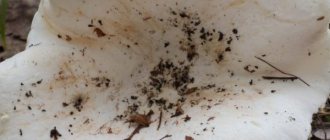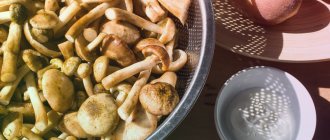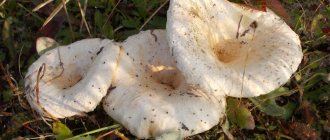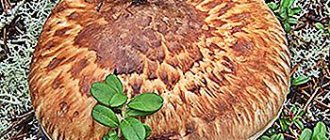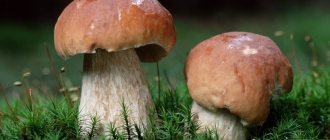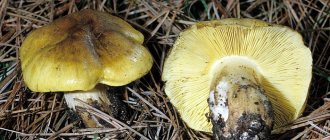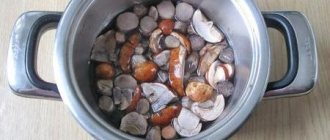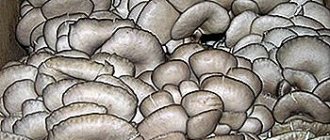Preparatory stage: how to clean
Finding and collecting mushrooms is just the beginning. Next they have to be cooked. To ensure that the taste of the prepared dish does not disappoint the consumer, you should know all the features of the preparatory stage - cleaning.
Ryadovka, like most other mushrooms, grows in forest conditions. Therefore, the first thing to do is to thoroughly clean the entire surface of adhering pine needles, moss, and leaves. You can get rid of sand and soil with an ordinary brush. Particular attention should be paid to the bottom of the cap - there are plates here that easily become clogged.
After the debris has been removed, we proceed to the main part of the answer to the question of how to clean the rows. Using a sharp stainless steel knife, remove areas from the mushroom cap that are darkened or damaged by rot, rodents, or insects. Be sure to remove the skin from the cap, after which the mushrooms are thoroughly washed under running water.
If the collected specimens are too dirty, they are placed in a large saucepan or basin, filled with water and left for a while. Soaking does not affect the taste of the final product in any way, even if you plan to cook fried rows. It is important to remember that their stay in water should not be long, since the caps easily absorb moisture.
Collection rules and conditions
The rules for collecting mushrooms are the same for all edible varieties. In order for the autumn gifts of the forest to bring only benefits, you must adhere to the following tips:
- Do not collect within the city, near highways or near natural dumps.
- Do not pick spoiled, wormy or very old specimens. They can be poisoned.
- If an edible mushroom grows next to a poisonous one, then you should not put it in the basket. Also, if a poisonous mushroom was found in the basket, it is advisable to throw away the entire crop that was in the neighborhood.
Safety rules when picking mushrooms - You should look for the gifts of the forest using a thin stick, carefully moving the needles apart. This will protect the fruiting bodies from damage, and the mushroom picker from poisoning by mushrooms, the toxins of which penetrate even through the skin (for example, toadstool).
- If some collected specimen does not fit, then you should not crush it, just prick it on a branch so that it ripens and sows spores.
- Before taking children into the forest, it is necessary to provide instructions and explain that they should not eat anything picked in the forest.
How and how long to cook the rows until done
Regardless of which method of storing mushrooms was chosen, they should be processed in a special way. The rows are thoroughly cleaned and washed under running water.
How to cook rows? This process is carried out in several stages:
- Cold water is poured into a spacious container. Salt is also added here. To determine the amount of liquid and salt, use the following formula: 1 liter of water + 1 kg of mushrooms + 1 tbsp. salt. You should also definitely add about a quarter teaspoon of citric acid to the water - it will act as a preservative. To stir thoroughly.
- As soon as the water boils, add mushrooms to the pan.
- After 10 minutes, add black peppercorns, bay leaf, and dry cloves.
- After the mushrooms are cooked, they are discarded in a colander. As soon as the moisture has completely disappeared, you can begin further preparation.
How long to cook the rows until done? This will take about 20 minutes. The fire should be medium. The container must be covered with a lid to prevent mushrooms from floating.
Recipes for dishes from boiled rows
To prepare fried rows you will need:
- vegetable oil – 1 tbsp. spoon;
- mushrooms – 0.5 kg;
- salt and spices to taste.
Fried rows
Pre-cooked mushrooms are placed in a previously heated frying pan with vegetable oil and fried for 10 minutes. The mushrooms must be stirred periodically, otherwise they will burn. Afterwards you need to add salt and spices to taste. Together with the spices, the rows must be kept on the fire for a few more minutes. The dish can be served with any side dish, but rows, as a rule, go well with potatoes.
To prepare baked rows you need to take:
- boiled mushrooms – 500 g;
- boiled potatoes – 300 g;
- breadcrumbs - 2 tbsp. spoons;
- butter – 100 g;
- onions – 2 pcs.;
- sour cream – 200 ml;
- eggs – 3 pcs.;
- salt and pepper to taste.
Cooking options
You can find many ways to process rows. Let's look at the best recipes for preparing rows, tested many times.
Recipe 1. Preparation of gray row
The gray row is a fairly large mushroom. The main collection time is autumn, the place is pine or mixed forests. Despite their age, the mushroom pulp retains its shape well. It doesn't become soft or crumbly. Therefore, the preparation of gray row involves salting and marinating. But it turns out especially tasty when marinated.
The best utensils for marinating are those made of wood. As a rule, this is a tub or bucket. Although today, more and more often, recipes recommend using the usual glass jars. How to prepare a gray row?
Option one
- 1 kg of mushrooms;
- salt (2 tsp);
- citric acid (0.5 tsp);
- water (half a glass);
- sugar (2 tsp);
- vinegar (half a glass);
- bay leaf, dill, cloves, black pepper and cinnamon.
The ingredients given are the basis. All recipes are based on it; a lot of individual components may change.
Preparing mushrooms involves sorting and cleaning. Small specimens are marinated whole, larger ones are cut into several parts. In the latter case, the mushrooms are placed in water with citric acid and salt.
Clean rows are boiled with the addition of vinegar (salt is added if small mushrooms are prepared). As soon as the liquid boils, remove the resulting foam. How long to cook? Until the moment when the rows settle to the bottom. After this, they are pulled out with a slotted spoon and placed in prepared containers. Dry ingredients are added to the remaining cooking liquid. After it boils again, the resulting marinade is poured into jars with mushrooms, covered with a lid and sterilized for 30 minutes over low heat. Then the containers are rolled up and put away in a dark place.
Option two
This method will additionally require a wooden tub, bending and dry cloth. The preliminary stage also involves cleaning and boiling the mushrooms. The finished row is washed with cold running water, discarded in a colander or a bag made of loosely woven fabric and left for a while so that the remaining liquid is completely drained.
Dried mushrooms are placed in layers in a tub and sprinkled with salt (45-60 g of it will be required per 1 kg of ready-made mushrooms). The top is covered with a circle of wood and pressed down with pressure. The rows will be ready for use in about a week.
Useful properties and restrictions on use
In terms of its beneficial properties, rowing is a unique product. They counteract viruses, bacteria, and have antioxidant properties. Normalize blood pressure, blood sugar, strengthen blood vessels, restore liver cells. They have anti-cancer properties. An extract is prepared from the mycelium for the treatment of cancer in various locations.
Good to know!
The suppressive effect on the tuberculosis bacillus has been proven. They are raw materials for drugs for rheumatism. In folk medicine, an ointment for skin diseases is made from the extract.
The row contains 9 minerals, 18 types of amino acids, vitamins, a whole range of biologically active substances and natural antibiotics - clitocin and fomecin.
Despite such extensive medicinal properties, excessive consumption of the mushroom can cause gastrointestinal upset, pain and increased gas formation. Eating raw is dangerous due to the mushroom's ability to accumulate heavy metals and contaminants.
It is important to remember that children under seven years of age are prohibited from eating mushrooms. Teenagers and people with any chronic diseases or allergies should also take this product in doses.
Recipe 2. Method of preparing purple row
You can prepare the purple row in any way. Quite often its fruity aroma is used in mushroom pates.
This method of preparing purple row will require the following ingredients:
- 300 g onions;
- 3 tbsp. l. vegetable oil;
- salt, garlic to taste.
The norms are calculated for 1 kg of mushrooms.
The starting product is cleaned, washed with cold water and boiled in salted water. The onion is fried in a frying pan until golden brown, then the prepared rows are added to it. The ingredients are well fried for an average of 20-30 minutes. At the end, add salt and garlic to taste, then put it in a blender and grind it to a paste.
For long-term storage, the resulting mass is fried again, and then placed in jars and rolled up.
Recipe 3. Preparation of poplar row
Mushroom pickers love this type of mushroom not only for its external resemblance to boletus (the color of the cap), but also for its pleasant, delicate taste. They got their name from their favorite place of growth - near poplars. You can prepare poplar rows using different methods:
Preparing poplar row by salting allows you to better preserve the appearance of the mushroom, the density of its pulp and taste. Ingredients required for 1 kg of original product:
- salt (2 tbsp);
- black pepper (5-6 peas);
- bay leaf (1 pc.);
- cloves (3 inflorescences);
- dried dill (5 sprigs);
- cherry/horseradish leaves (2 pcs.).
How to salt floodplains
Salted podtopolniks are a favorite dish of many people. The method of preparing them should be considered step by step:
- Prepare a solution for pouring mushrooms (50 grams of salt per 1 kg of rows).
- Add spices (optional). You will get a delicious salting if you use tomatoes.
- Place the mushrooms in a suitable container, caps down, and fill with brine.
- Leave the rows in brine for several days in a dark and cool place.
- Prepared salted floodplains are stored in cold rooms.
Attention! To protect the brine from mold, add a spoonful of crushed mustard to the surface under the lid.
How to clean row mushrooms
The rows grow in large colonies, arranged in stripes or circles. Therefore, they are usually collected quickly, without much concern for cleanliness. As a result, collected mushrooms at home have to be sorted out, clearing them of adhering debris. It is most convenient to do this with a short knife, since along with cleaning you need to trim the lower part of the leg.
If the mushrooms have dried out, it becomes much more difficult to clean them. The adhering debris dries to the skin, and it becomes impossible to remove it without damaging the fruiting body. In this case, you can pre-soak the harvested crop in cold water for half an hour and then rinse it under the tap.
Do I need to soak the rows? Do I need to clean the rows and how to do it dry?
Some housewives may wonder whether it is necessary to clean row mushrooms at all? So, this is a very important process, because the quality of the final product will depend on it. In addition, all types of rows grow on the soil, preferring to settle on fallen leaves and pine needles, as well as on moss. Thus, contamination will definitely be present, which means cleaning will be necessary. The following methods will show you how to properly clean row mushrooms.
Sometimes a lot of debris collects on the fruiting body, then you can use the dry method. Some housewives prefer to freeze or dry rows, so in this case their contact with water should be minimized. Here it is best to resort to dry cleaning. To ensure that the taste of the prepared delicacy does not upset the consumer, it is necessary to take into account all the features of the preparatory stage. So, how to properly clean row mushrooms using the dry method?
To do this, we need to take an ordinary kitchen knife that will be comfortable to hold in your hand, a kitchen sponge or toothbrush, and vegetable oil. Using a knife, we remove all large contaminants on the fruiting body, and also pay attention to damaged areas. Such places need to be carefully cut off, capturing the “healthy” part of the mushroom.
Remember that the fruiting body is allowed for further use only if the affected area is no more than 20% of the total area of the mushroom.
In addition, you need to cut off the lower part of the leg, because it is usually very hard. Sometimes you can notice that the cap is damaged, but the stem is not, and vice versa. In this case, only the damaged part of the fruit body is removed, and the strong and intact part remains for further processing processes. In addition, do not forget to look under the cap, because a lot of microscopic debris collects in the plates.
How to properly clean the rows further using the mentioned equipment? We put the knife aside, and in the meantime, moisten a kitchen sponge or toothbrush in vegetable oil and wipe the surface of the mushroom. We pay special attention to areas with remains of stuck leaves, pine needles and other forest debris. If necessary, lightly rinse the mushrooms under the tap, and then proceed to further processing: boiling (required), freezing, pickling, etc.
How long to cook row mushrooms
Boiling is one of the types of heat treatment of mushrooms. During the cooking process, not only harmful but also aromatic substances pass into the broth, which give the finished dish a characteristic taste and aroma. If you do this for too long, not only the taste, but also the appearance of the mushrooms deteriorates. Therefore, it takes a certain amount of time to cook the rows.
How long to cook row mushrooms before frying
Before you start frying the rows, they must be thoroughly washed and soaked. After this, the mushrooms are placed in a colander, allowing all excess liquid to drain. In the meantime, you need to boil water, adding salt to it at the rate of 1 tsp. per 1 kg of rows. After this, you need to pour the mushrooms into boiling water. Boiling is carried out for 15 minutes. All this time you need to skim the foam from the surface of the boiling water.
After this time, the fruiting bodies are again placed in a colander and washed with running cold water. You need to let the mushrooms dry for a few minutes. Drain the water in the pan and add fresh water, bring it to a boil, add the same amount of salt and put the mushrooms back in. After a quarter of an hour, the finished rows can be removed from the pan, washed and fried.
How long to cook rows for salting and pickling
The rows are suitable for canning; they can be salted and pickled. Before marinating, the mushrooms are thoroughly washed to remove debris. Then they are boiled twice for 15 minutes, rinsing in between with cold running water. After the mushrooms are boiled in 2 waters, they are transferred to a colander, washed and allowed to dry. After such heat treatment, the rows can be pickled. Any remaining bitterness in the taste will be removed by a marinade containing spices and garlic.
Some mushroom pickers use the cold pickling method, preferring to soak these mushrooms for several days instead of boiling. However, this is not always justified. Rowers are quite variable mushrooms that easily adapt and adapt to the environment. This also applies to their appearance. Therefore, even an experienced mushroom picker can confuse edible rows with inedible ones.
Before salting, the rows are cleared of debris, washed thoroughly, and then boiled twice in boiling water, slightly acidified with vinegar. Cook the rows until done for at least 20 minutes. After the first boiling, the water must be replaced with fresh water. The boiled mushrooms are placed in a colander, washed with cold water, and allowed to drain and cool. After this, you can start salting.
How long to cook rows for freezing
Unlike many agaric mushrooms, rows can be frozen for storage and later use. Before freezing, boil them 3 times for 10 minutes, changing the water each time. To preserve the natural color and get rid of the mealy taste, add a little vinegar to the water, as well as a couple of bay leaves and one chopped onion.
After boiling, the mushrooms are allowed to drain and cool, but it is advisable to place them under pressure so that they give up as much liquid as possible. Otherwise, after defrosting, their taste will be watery. Then the rows are laid out in plastic bags and wrapped in such a way as to form a layer. It is important that a minimum amount of air remains inside. After this, the bags are stored in a chest freezer.
How long to cook the rows before baking
One way to preserve rows for the winter is to bake them in the oven and then put them in jars. The collected mushrooms are washed, removing all dirt and adhering debris, and then soaked for 2 days. Next, the rows are boiled twice in salted water with the addition of citric acid, each time keeping them on low heat for 15 minutes and removing the foam. After cooking, the mushrooms are rinsed each time with running water.
After the rows are boiled a second time, they are finally washed, the water is allowed to drain, and then they are laid out on a baking sheet greased with vegetable oil. The mushrooms are salted, sprinkled with ground black pepper on top, and then baked for half an hour at a temperature of + 180 °C. Then they are taken out of the oven, placed in sterilized jars and covered with plastic lids. After cooling, you need to put the jars with the finished product in a dark, cool place, such as a cellar.
Is it necessary to soak the rows?
Rowers are a large family of agaric mushrooms, and only some of them can be safely eaten.
They have a large number of useful microelements, including zinc, copper, manganese, as well as B vitamins. In addition, they exhibit antibacterial properties.
But in order to preserve all the useful components contained in the fruiting body, it is necessary to cook row mushrooms correctly, strictly adhering to the technology.
How to properly soak and boil milk mushrooms?
Regardless of the salting method, fresh milk mushrooms must undergo mandatory pre-treatment. It consists of several stages:
- First, the products are sorted, throwing out completely damaged ones and removing wormy places from the rest.
- Next, we clean the mushrooms from dirt. It can be quite corrosive and dense, so it is better to initially arm yourself with a brush. If this does not help, soak the milk mushrooms for a couple of hours in cold water and repeat the treatment.
- It is recommended to immediately cut the peeled mushrooms in accordance with the requirements of the pickling option (into 2-4 parts or the stem is separated from the cap).
- Before cooking or cold-salting the product, it must be soaked, otherwise the bitterness will not go away. We put all the products in a container of a suitable size, fill them with cold water (you can add a little fine table salt), cover them with a lid of a smaller diameter and put pressure on them so that the mushrooms do not float. For this you need to use only glass, wooden or enamel dishes; other materials can spoil the product. How long to keep milk mushrooms in this form depends on their freshness and quality. It is better to take your time and wait 2-3 days, and change the water at least twice a day.
Tip: The most delicious milk mushrooms are traditionally considered to be salted without legs, but this does not mean that unnecessary parts of the mushrooms should be thrown away. It is from the legs that delicious and tender mushroom caviar is obtained; you just need to choose the appropriate recipe.
We wash the soaked milk mushrooms several times, paying attention to each mushroom. Next, depending on the salting option, the workpieces must either be boiled or immediately sent for preparation of the workpieces.
Cooking the product is very simple:
- Place it in a saucepan with cold water. There should be enough liquid so that the elements float freely and do not squeeze each other, so it is better to make several passes.
- Bring the mixture to a boil, reduce the heat to low and note the time.
- Cook the milk mushrooms for 15 minutes, no matter how long they are soaked. Next, we take out the products (rather than draining the water, which leads to damage to the caps) and use them for their intended purpose.
There is one more rule that should be followed when preparing canned milk mushrooms. It is better to collect them yourself, and in places that are largely remote from roads and industrial enterprises.
Mushrooms growing in areas with an environmentally unfavorable situation absorb all harmful substances from the environment and soil.
Their use causes irreparable damage to the body, no matter the intensity of the pre-treatment.
How to soak heavily salted milk mushrooms from salt
Salted or bitter-tasting milk mushrooms are soaked to improve their taste. The washed mushrooms are placed in cold water and soaked for usually 2–6 hours. Before soaking over-salted milk mushrooms, you need to prepare for the fact that the water is changed every hour so that the unwanted substances dissolve faster.
Dried milk mushrooms are soaked to restore moisture. The water in which they were soaked is used for food. Many salted milk mushrooms have a bitter, pungent or unpleasant taste and smell. It is important to know how to soak salted milk mushrooms correctly without spoiling the product.
Simple tips on how to soak highly salted milk mushrooms can be found on this page.
We recommend reading: How to Store Cream Cheese in Butter
These shortcomings are eliminated if you soak the mushrooms in water for 2-3 days or boil them well. Place the mushrooms in a bowl and add cold salted water (1 liter of water per 5 kg of mushrooms). Cover with a napkin, then with a wooden circle, with a weight on top. Place the dishes with soaked mushrooms in the cold, preferably a refrigerator, so that they do not sour.
Depending on the type of milk mushroom, the soaking time is from 1 to 3 days.
The water is changed at least once a day. Sometimes it is better to replace soaking with scalding. Milk mushrooms, podgruzdi (dry milk mushrooms) are dipped in boiling water and cooked for 5 to 30 minutes. The water must be thrown away after each cooking or scalding.
After cooking the mushrooms, the pan should be thoroughly wiped with dry salt, washed thoroughly and wiped dry. Before soaking milk mushrooms from salt, you need to measure out exactly the amount that will be used to prepare the dish.
Useful tips
Eating mushrooms always carries a certain risk. Here are some useful tips for those who want to collect in the forest for the first time and try to prepare rows:
- When “silent hunting” you should always be guided by the rule: “I don’t know - I don’t take.” No mushroom is worth risking your health or life for.
- During the growth process, fungi intensively absorb toxins, radionuclides, heavy metals and various chemical compounds from the environment. For this reason, they cannot be collected within the city, near highways and railways, in the territories of operating and closed enterprises, and in industrial zones.
- Rowers belong to the fourth category of mushrooms, which have the lowest nutritional value. In many regions, mushroom pickers ignore them, especially if there are more valuable specimens in the forest. This is completely justified. If it is possible to collect mushrooms of a higher category of nutritional value, then there is no point in collecting rows. Perhaps for the sake of a culinary experiment.
- Rows are characterized by inconstancy. Some species are quite similar, and they can often only be distinguished using microbiological analysis. If you collect everything, then the harvest may well contain both inedible and poisonous species. That’s why it’s so important to thoroughly soak and boil these mushrooms. In this case, it is possible to minimize the harmful effects of toxins on the body, even if inedible or poisonous ones are found among the collected specimens.
- Symptoms of mushroom poisoning may include nausea, dizziness, and stomach upset. Toxins can cause high or low blood pressure, rapid heartbeat, and weakness. Some poisoned people experience mental disorders, since among the rows there are also hallucinogenic species.
At the first signs of poisoning, you need to rinse your stomach, to do this you need to drink a large amount of water or a weak solution of potassium permanganate, and then induce vomiting. To reduce the absorption of toxins into the stomach, it is advisable to drink an absorbent drug (activated carbon, Polysorb, Enterosgel) after rinsing.
Purple row: photo and description
Violet row (Lepista glabra) belongs to the species representing the genus Lepista, family Rowaceae
. The mushroom is classified as conditionally edible, which means that it is strictly forbidden to eat it raw.
Therefore, in order to enjoy the row, it must be thoroughly boiled, and only then subjected to basic culinary processing.
Video: what a purple row looks like
But this does not mean at all that Lepista glabra is a dangerous and poisonous mushroom; it does not contain highly toxic substances, but consuming such a product in its raw form can cause serious stomach upset.
Did you know?
The first mention of such a life form as mushrooms occurs in IV BC.
e. in the works of the ancient Greek philosopher Aristotle. In addition, the rower has a rather bright appearance, similar to some poisonous representatives of the mushroom kingdom, so in order for its use not to result in serious consequences, it is necessary to carefully understand the morphological characteristics of the species.
The cap of all representatives of the species can reach a diameter of 6-15 cm. Initially, its color is a distinct purple hue, but over time it changes to pale lilac with a slight manifestation of brown tones. Often the cap is flat or slightly convex, its edges are not uniform.
Its structure is dense and fleshy, but sometimes it can be watery. The lower part of the cap, bearing the spore-bearing organs, is also a bright purple hue, which fades over time to a grayish-purple color.
Pulp
The pulp of the young row is fleshy, dense, almost always elastic, and grayish-purple in color. Over time, it becomes softer, and its shade changes to ocher-cream tones. The mushroom has a characteristic smell; it is predominantly a persistent but pleasant aroma of anise.
Records
The plates are always numerous, thin and wide, attached to the teeth, but in some cases crescent-shaped, almost always free.
They initially have a bright purple hue, which fades over time to a soft light purple color.
The leg of all representatives of the species is smooth, smooth and fibrous, cylindrical in shape and thickens towards the base. In young mushrooms it is solid, but over time, cavities form in the stem. Under the cap there is a flaky coating on it. Its color ranges from light purple to slightly pale shades of lilac. The height of the leg can reach from 4 to 8 cm, thickness - no more than 1.5-2.5 cm.
At the base of the leg, purple pubescence develops - the so-called.
Spores and spore powder
The spore powder in the row is always light pink or pinkish-yellow.
The spores are small and numerous, slightly rough, ellipsoidal in shape, pink in color. Their length is in the range of 6-8 microns, width no more than 4-5 microns.
Did you know?
In nature, there are predator fungi, these are representatives of the genera Arthrobotrys, Dactylaria, Monacroporium, Tridentaria, Trypospormna. Using mycelium, they create small traps for catching and poisoning small soil worms.
Lepista glabra is ubiquitous throughout the Northern Hemisphere, in temperate climates. This is an unpretentious saprophytic species that can be found in forests with diverse vegetation, but in most cases the species is a faithful companion of fir-hornbeam, pine or spruce plantings.
The substrate for row growth can be any leaf or coniferous litter, but it grows best on coniferous or deciduous humus. Lepista is found in open forest areas, usually in groups of several individuals or in small densely populated clearings.
The species can also be found along forest roads, in ditches, in the needles of spruce or pine forests, and even in garden plots close to the forest, near compost, brushwood or straw heaps.
The traditional companion of the purple row is the smoky talker, which is found nearby in small groups or numerous cenoses.
Rowing is collected throughout the fall, from the beginning of September until the first serious frost.
Despite its bright and uncharacteristic coloring for our climate zone, lepista is still not unique, so it’s quite easy to come across a species similar to it.
In most cases, related species disappear into the basket, which, after careful processing, are quite suitable for preparing all kinds of dishes.
However, inexperienced mushroom pickers often fall into the hands of truly dangerous species, the consumption of which can result in severe poisoning. Next, we will look in detail at who may be hiding behind the lepista mask and whether such mushrooms should be consumed.
Did you know?
The largest mushroom in the world was found on Hanan Island in 2011 by Chinese Academy of Sciences scientist Yu Cheng Daem. Its weight was about 500 kg.
Edible
Most often, lepista can be confused with non-toxic related species belonging to the family Oryadaceae. These include:
Did you know?
The most expensive mushroom in the world is considered to be the white truffle, and the price for such a product can reach $100,000 per 1 kg.
Inedible
You should especially be wary of the following violet row doubles:
Important!
If you are not an experienced mushroom picker, take the time to cut each collected specimen. A sign of true rowing will be the appearance of a distinct purple tint on the cut.
Classic marinating option
The recipe is quick and easy. It doesn't require any effort, but the taste is unusual. The love for the snack manifests itself after trying one mushroom. Let's look at how to prepare a gray row:
- fresh mushrooms - 2 kg;
- granulated sugar - 50 g;
- table salt - 120 g;
- table vinegar - 200 ml;
- bay leaf - 4 leaves;
- black peppercorns - 10 pcs.;
- cloves - 4 inflorescences;
- garlic - 4 cloves;
- dill umbrellas - 4 pcs.;
- currant leaves - 2 pcs.
- Carefully sort the main ingredient, remove spoiled and wormy ones. You need to taste the stem on your tongue and, if you feel the taste of bitterness, soak the mushrooms in very cold water for 2-3 days with the obligatory change of water at least 3 times a day. Rinse under water, place in a colander and rinse with boiling water.
- Place the prepared rows in a saucepan and fill with filtered liquid. Add salt and granulated sugar and place on the stove. After boiling, cook for 25 minutes. During cooking, it is necessary to remove the foam. The transparency of the marinade will depend on this action. Drain in a colander and leave the broth in the container.
- Wash the jars with soap and dry in the oven.
- Peel the garlic, wash and chop into slices. Pour boiling water over dill inflorescences and currant leaves.
- Place 1/2 of the prepared spices on the bottom of the containers, including peppercorns and cloves. After that, distribute the mushrooms, and on top of them the remaining seasonings, pour in the acid.
- Bring the mushroom broth to a boil, fill the jars with the contents and seal tightly. Turn over, cool and store in the cellar.
Symptoms of poisoning and first aid
The main cause of poisoning is the inability to recognize edible and false mushrooms. Therefore, if you are not sure that you have identified the specimen correctly, it is better to leave it in the forest. Intoxication can also be caused by eating raw mushrooms, improper processing and preparation.
Signs of mushroom poisoning
Signs of poisoning appear within 1.5-2 hours after consumption. This may include nausea, vomiting, chills, slow heart rate, fever, diarrhea and stomach cramps.
At the first signs of poisoning, you must urgently take sorbents, perform gastric lavage and consult a doctor. It is advisable to maintain bed rest and drink plenty of cold liquids.
Basic methods of pickling
There are several options for pickling mushrooms. Let's look at the 2 most common options for salting row mushrooms for the winter.
Cold
This method takes longer to prepare, but the “forest fruits” turn out tasty, salty and crunchy, like lightly salted cucumbers.
- fresh mushrooms - 2 kg;
- garlic - 6 cloves;
- horseradish leaf - 6 sheets;
- fresh dill - 15 g;
- peppercorns - 20 pcs.;
- if not iodized - 100 g.
- Sort out the main ingredient, remove debris and twigs. Rinse under running water several times. It’s better to try the stem on your tongue and, if you feel the taste of bitterness, soak the mushrooms in very cold water for 2-3 days with the obligatory change of water at least 3 times a day. Place in a saucepan, fill with liquid, place on the stove and cook for 2-3 minutes. After the time has passed, drain in a colander and wait for the excess moisture to completely drain.
- Place washed horseradish leaves in the bottom of sterile glass containers, then alternately sprinkle each layer with coarse salt. Between the layers it is necessary to lay garlic, previously peeled and chopped into slices.
- Finally, place fresh dill. Cover with plastic lids. Store in a cool place for 45 days. After the time has passed, the snack can be consumed. Shelf life: 12 months if storage standards are observed.
Hot
Mushrooms prepared using this method can be consumed 7 days after canning. Based on the above, this method of salting rows can be considered as fast.
- fresh mushrooms - 2 kg;
- filtered water - 3 l;
- table salt - 150 g;
- bay leaf - 6 pcs.;
- peppercorns - 20 pcs.;
- cloves - 10 inflorescences;
- sweet peas - 10 pcs.
- Sort out the main ingredient, clean and rinse in several waters. Pay attention to point 1 of the previous recipe.
- Pour the required amount of liquid into a saucepan, add rock salt, bay leaf, 2 types of pepper, and cloves. Bring to a boil, simmer for several minutes with constant stirring. Add the prepared mushrooms, after boiling again, reduce the heat, cover and cook for 45 minutes.
- Meanwhile, wash the jars with soap and dry in the oven. Place the rows into glass containers and pour the brine evenly.
- After cooling, close tightly and refrigerate for 1.5 months. After a week, the snack can be consumed, but the bright, aromatic taste will appear only after the specified time.
How to salt rows using the cold method. Cold pressed method
To pickle row mushrooms using the cold method, you will need a deep container and a press. For example, you can use a basin and a large dish, and instead of a press, take something heavy, some kind of weight (a bucket of water or a three-liter jar, if the container is small).
The mushrooms must be prepared, that is, they need to be washed and peeled. At the bottom of the container where the rows will be salted, place leaves and chopped roots of horseradish, bay leaf and currant leaves. They must first be washed with cold water and then doused with boiling water. Be sure to peel or scrape the roots with a knife and cut them into pieces of approximately 2-3 cm.
Now you can lay out the mushrooms in one layer, salt them, add black peppercorns and a few sprigs of cloves. Do it all over again. As a result, seasonings will alternate with mushrooms. The topmost layer should consist of horseradish leaves. Place a large dish on top. It should be slightly smaller in diameter than the pickling container. And you should put a load on it. The container with mushrooms will need to be put in a cool place.
The cooking time using the cold method is one and a half months. It is this method that allows you to preserve not only the beneficial substances in the rows, but also their taste, structure and aroma of all ingredients. They turn out very rich, savory and are great as an addition to any dish or can be used as an independent snack.
Pickling poplar row
This type of mushroom differs in appearance and taste from its garden counterparts. Consequently, canning forest fruits occurs in a special way. The process is simple and the end result is delicious. The color of the row can be either brown or purple, but we’ll look at how to cook it further.
- fresh mushrooms - 2 kg;
- essence - 55 ml;
- non-iodized salt - 120 g;
- granulated sugar - 100 g;
- laurel - 4 leaves;
- carnation inflorescences - 4 pcs.;
- peppercorns - 20 pcs.
The procedure is as follows:
- Before cooking, the main component must be soaked. To do this, first of all, sort out the fruits, rinse them in several waters and place them in an enamel pan. Fill with ice liquid, cover and leave for 2-3 days. Be sure to change the fluid (at least 3 times). Place on a sieve and rinse.
- Place in a saucepan, fill with water, add a little salt and put on the stove. After boiling, cook for 15 minutes. After the time has passed, drain the liquid, repeat the process and continue cooking for 40 minutes. The readiness of the product is determined as follows: the mushrooms sink to the bottom of the pan.
- Now let's start preparing the marinade. Pour liquid into a saucepan, add salt, granulated sugar and add all the prepared spices. After boiling, cook on low heat for 15 minutes. Then add acid and heat for another 3-5 minutes.
- Wash the jars with soap and sterilize over steam. Place the mushrooms in a sterile container and distribute the marinade evenly. Roll up, turn over, cool and store in the cellar.
And they will be good in winter!
How to pickle rows
Products
Rows – 1 kilogram Vinegar 6% – 3 tablespoons Sugar – one and a half tablespoons Peppercorns – 5 pieces Salt – tablespoon Bay leaf – 2 leaves Cloves – 4 inflorescences
How to pickle rows
1. Select strong rows. 2. Cut large rows, leave small ones as they are. 3. Place the rows in a pan, cook, skimming off the foam. 4. Add vinegar and stir. 5. Without cooling, transfer the rows into sterilized jars and close. 6. Close the jars, cool and store in a cool place.
Mushroom appetizer with vegetables
The combination of forest products and vegetables makes the preparation especially tasty. Non-standard spices in this recipe for preparing rows of mushrooms change the taste of the mushrooms themselves, thereby making them more refined.
- rows - 3 kg;
- wine vinegar - 200 ml;
- filtered water - 600 ml;
- leek - 200 g;
- carrots - 2 pcs.;
- bay leaf - 4 leaves;
- tarragon - 7 g;
- borage - 1 tsp;
- non-iodized salt - 120 g;
- zest of one lemon;
- granulated sugar - 10 g.
The algorithm of actions is as follows:
- Sort freshly picked mushrooms, remove rotten and unsuitable for food. Rinse in several waters. It’s even better to try the stem on your tongue and, if you feel the taste of bitterness, soak the mushrooms in very cold water for 2-3 days, always changing the water at least 3 times a day. Cut off most of the legs. Pour a small amount of liquid into the pan, bring to a boil and place the prepared forest fruits. Cook over low heat for 5 minutes, drain on a sieve.
- Wash the carrots, peel off the skin in a thin layer, and chop into slices. Do the same with leeks. place in a saucepan, combine with water, salt, vinegar and spicy ingredients. Cook on medium heat for 15 minutes.
- Mix mushrooms with vegetable marinade and continue cooking for 5 minutes.
- Wash the jars with soap and dry in the oven. Place vegetables and rows tightly in sterile containers and fill evenly with hot marinade. Seat tightly, turn over and cool. Put it in the cellar.
Salting
Brining a row is as easy as boiling it, and again there are a variety of recipes out there, but it's best to start with the basics so you can create your own and unique way of cooking along the way.
Firstly, it is better to salt the rows in the fall, when it is already cool outside, and the autumn rows are denser and crispier than the spring ones. Secondly, it is better to salt small rows, and the smaller they are, the better. Too large individuals become quite tough during salting, which is not to everyone’s taste.
And now directly about how to salt these rows. In fact, this process is very similar to cooking, only you should add a bay leaf, more salt and spices to a pan of water. And the mushrooms should be cooked in this way a little longer, namely they should boil for 45 minutes.
After that, they are put into a jar along with the brine, closed with a lid and taken to a cool place for 40 days.
As you can see, preparing salted rows is very simple and quick. If desired, you can add other spices and seasonings to the marinade. In any case, the finished product will be delicious. But don’t forget that there are also recipes for pickling these mushrooms.
When pickling, the smaller the mushrooms, the better.
You can pickle mushrooms at home only after prolonged soaking and careful heat treatment. But if you treat the canning process responsibly and follow all the rules, then the row-based preparations for the winter will turn out to be safe and very tasty.
Some varieties of these mushrooms are classified as inedible and poisonous (soapy, pointed, sulfur-yellow, etc.), while those that are conditionally edible (gray and purple) have low nutritional value - belong to the 4th category.
With citric acid
The acidity of the lemon gives the marinade a special taste. Mushrooms cooked in this filling are obtained with an unusual taste and aroma. An ordinary lemon in the recipe for pickled rows allows you to surprise guests with the brightness and richness of the preparation.
- main ingredient - 2 kg;
- filtered water - 200 ml;
- table salt - 90 g;
- table vinegar - 200 ml;
- citric acid - 0.5 tsp;
- granulated sugar - 40 g;
- bay leaf - 4 leaves;
- dill greens - 30 g;
- black peppercorns - 10 pcs.;
- cinnamon - 0.5 tsp;
- carnation - 4 inflorescences.
- Sort the mushrooms, remove rotten specimens. Wash under running water, cut larger species into several pieces. Check the stem for bitterness with your tongue and if you feel it, pour ice water over the mushrooms for 2-3 days, changing them at least 3 times a day. Fill the pan with liquid, add salt and acid, stir. Dip the prepared rows into it, and after boiling, cook for 20-30 minutes, regularly removing the foam from the surface. During the specified time, the mushrooms should sink to the bottom of the pan. Otherwise, the cooking time will increase.
- As soon as the “forest gifts” have settled, you need to add citric acid and other seasonings and spices specified in the recipe to the pan. Add granulated sugar and boil.
- Wash the jars with soap and sterilize in a convenient way. Using a slotted spoon, evenly distribute the mushrooms among the prepared containers and fill with marinade. Cover and place to sterilize in water for half an hour after boiling. Carefully remove, roll up, turn over. Cool and store in the cellar.
Nuances of cleaning fresh edible mushrooms
More than 380 species of edible mushrooms grow in the European part of Russia alone . Of course, the figure seems huge. But there are about 4 dozen species of russula, more than 20 types of edible milk mushrooms, and the most delicious, porcini mushrooms - 10 species. And each mushroom should have its own approach. For lamellar, tubular (spongy) mushrooms, as well as morels and rain mushrooms, there are different cleaning nuances.
How to clean sponge mushrooms
Sponge mushrooms include species in which the lower surface of the cap resembles a sponge:
- white;
- redheads - boletus and boletus;
- boletus;
- flywheels;
- Polish mushroom;
- goats and others.
White mushrooms
They do not require intensive cleaning after harvesting.
- It is enough to wipe the surface of the cap with a damp cloth and remove any stuck grains of sand with a knife.
- To check if the mushroom is wormy, cut off the base of the stem.
- Place in a colander and rinse with running water.
Sticky soil from the stem of a porcini mushroom can be cleaned off with a knife.
How to remove the spongy layer on the moss fly cap
- We cut the leg along the edge of the cut.
- If the base has darkened, clean off the top layer.
- Remove the spongy layer on the cap. If this is not done, the mushroom will darken and become slimy during cooking.
- To make it easier to remove the spongy part, place the mushrooms in cold water for 20–30 minutes.
The top layer of the stem of moss mushrooms needs to be peeled off.
Kozlyaki
There is no need to clean the goats in the usual sense. Their film is not as slimy as that of their relatives - they are oily. Therefore, we simply rinse the mushrooms thoroughly in water and check to see if we have caught any worms. A stem completely untouched by worms is not an indicator of a good mushroom. It's better to cut the cap in half.
Cleaning the goats simply means going through them and checking them for worms. Then cut and rinse with running cold water in a colander. In general, this is all the processing.
Barsko
https://www.bolshoyvopros.ru/questions/423995-kak-chistit-griby-kozljaki-nuzhno-li-ih-chistit.html
As practice has shown, and as experienced mushroom pickers advise, it is not at all necessary to peel the skin from the Kozlyak cap. It is better to pay more attention to washing the sponge and checking for worms (damage to the stem).
Mykhalich
https://www.bolshoyvopros.ru/questions/423995-kak-chistit-griby-kozljaki-nuzhno-li-ih-chistit.html
Polish mushroom
There is no need to clean it of sand and dirt. Rinse with cold water and cut into halves. If wormholes are present, cut off the damaged areas.
Polish mushroom can be washed quickly and easily under running water.
Redheads: boletus and boletus
It is customary to separate the stem from the cap of these mushrooms. We cut off the top layer from the leg with a knife, you can carefully scrape it. Rinse under running water. We wipe the caps with a damp cloth and cut them into halves to make sure there are no worms. Cut off the spongy part before cooking. There are several reasons for this.
- Mosquito larvae often live in the “sponge”.
- When cooked, the spongy part of redheads becomes slimy.
- It has pores that are difficult for our body to digest.
With Provençal herbs
This recipe requires a mixture of dry Provençal herbs. The mushrooms turn out tasty, aromatic and original in their own way.
- main ingredient - 1 kg;
- filtered water - 400 ml;
- table vinegar - 35 ml;
- non-iodized salt - 30 g;
- granulated sugar - 25 g;
- Provençal herbs - 5 g;
- peppercorns - 10 pcs.;
- bay leaf - 3 leaves.
- Sort freshly picked mushrooms, remove rotten parts and debris. Rinse under running water, place in an enamel container and fill with ice liquid. Cover and leave in this form for 2-3 days, changing the liquid from time to time. Place in a colander and rinse again.
- Place the main ingredient in a pan of salted water. After boiling, reduce heat and cook until fully cooked. Strain through a sieve and wait for excess moisture to drain.
- In a saucepan, combine liquid, salt, granulated sugar, bay leaf, and peppercorns. Place the container with the contents on the stove. Bring to a boil, stirring regularly. Heat for 10 minutes so that the bulk ingredients have time to completely dissolve. Remove from heat, pour in acid and stir.
- Wash the jars with soap and heat in the oven. Place the cooled mushrooms in glass containers and fill them with hot marinade. Cover and sterilize for half an hour. Carefully remove, roll up and turn over. Cool under a warm blanket, put in the cellar.
- Canned rows have a pleasant taste and a unique forest aroma. Therefore, in the fall, you should not miss the opportunity to collect and prepare several jars of crispy mushrooms for winter enjoyment.
How to cook rows in a frying pan. How long to fry the rows
How to fry rows
Products Fresh rows - 0.5 kilograms Water - 2 liters Salt - 1 tablespoon How to fry rows 1. Carefully sort out the rows, removing wormy mushrooms and cutting off rotten areas. 2. Cut off the root from each row. 3. Look under the caps of the rows and remove insects and forest debris. 4. Place the rows in a saucepan, add water and add salt. 5. Place the pan with the rows on the fire and bring to a boil. 6. Remove the foam with a slotted spoon or a tablespoon - it is important to carefully remove all the foam so that the finished rows do not emit a pungent odor. 7. Cook the rows after boiling for 20 minutes. 8. Drain the water through a colander and wait 5-7 minutes for excess water to drain. 9. Heat a frying pan over medium heat. 10. Pour oil, roll it over the entire surface of the frying pan, then lay out rows. 11. Fry the rows with regular stirring for 10 minutes. 12. Salt and pepper the rows to taste, fry for another 2 minutes.
Fkusnofacts
— Optionally, you can add onions, garlic, sour cream, and herbs to the rows when frying. Boiled pasta and fried potatoes are suitable as a side dish for fried rows. — If the ecology of the forest in which the rows are collected is in doubt, additionally, before the initial cooking, you should pour the mushrooms with salted cool water and leave for 2 hours. — To prevent the rows from turning pale during processing, it is recommended to add 1 pinch of citric acid during cooking. — To smooth out the sharp smell of rows, similar to the smell of radish and stale flour, you can add black pepper, dill and bay leaf. Less odor will come from young, medium-sized mushrooms. — Some types of rows are recognized as inedible or conditionally edible. If the mushrooms have a pronounced unpleasant odor, a pointed tubercle in appearance, sparse plates under the cap, or the surface of the cap is covered with dark spots, then under no circumstances should such mushrooms be taken for consumption. — The broth left over from the initial processing of mushrooms is not recommended for food. — Ryadovki belong to the 3rd category of taste (there are 5 of them in total, the best mushrooms are of the 1st category). Therefore, if when picking mushrooms there is no room in the basket and you see porcini mushrooms, you can safely throw away the rows and take their places with more tasty and healthy mushrooms.
New Year's rows
This dish will move from autumn straight to the New Year's table. The secret is that you need to collect the mushrooms themselves shortly before the first frost. Then the taste will be special.
The structure of the preparation is different due to unusual ingredients.
- Boil a kilogram of washed mushrooms;
- In another pan at this time, start preparing the marinade;
- Add two bay leaves, four dried cloves, a few peppercorns and two tablespoons of salt and sugar to it;
- Be sure to add vinegar at this stage (preferably a six percent solution);
- The marinade is cooked for about twenty minutes;
- At the end of cooking, it is important to pour the entire mixture with 70 percent vinegar essence;
- Accordingly, pour the marinade over the mushrooms and you can put them in jars.
Open a jar like this shortly before the New Year and you will understand what a special dish you have created.
How to pickle rows for the winter
Mushrooms that are marinated using wine vinegar rather than ordinary vinegar acquire an extraordinary taste and aroma. Even a minimal amount of spices allows the dish to fully develop.
You will need:
- floor l. wine vinegar;
- 1 onion;
- 1 carrot;
- a couple of laurel leaves;
- 5 peas of regular pepper;
- a couple of clove buds;
- a couple of tsp salt;
- a couple of tsp Sahara.
How to pickle mushrooms:
- Initially, the mushrooms are sorted, washed, and especially large specimens are cut.
- Already prepared mushrooms are laid out in a container suitable for subsequent actions and covered with water.
- They are boiled for about a quarter of an hour.
- The existing peel is removed from the onion and it is chopped very finely.
- The carrots are washed, naturally peeled and only then cut into miniature cubes.
- Vegetables are immersed in a container with wine vinegar. Spices are also added there.
- The marinade with vegetables should be boiled for about a quarter of an hour.
- The boiled mushrooms are added to the marinade, and the whole mixture is boiled for literally another five minutes.
- During this time, care should be taken to prepare the containers in which the canning will be carried out. It is washed with soda and subjected to sterilization necessary for long-term storage.
- Using a slotted spoon, remove all vegetables and mushrooms from the marinade. They are immediately placed in heat-treated jars.
- The marinade itself is boiled for about ten minutes and immediately transferred to jars.
- They are immediately rolled up.
Important! Separately, it is worth mentioning the dishes. To prepare mushrooms, you should absolutely not use containers that are prone to oxidation. This product absorbs all tastes and smells better than others. Nobody wants to receive a snack with a specific, very unpleasant metallic taste. The ideal option is a pan with an enamel coating. But even in this case, you should pay attention to the absence of chips. Even a tiny chip can ruin the entire preservation.
For thrifty housewives, we have also prepared dishes that will not only decorate your dining table, but will also become a wonderful and tasty addition to your dinner.
Recipes for marinating rows
When choosing a recipe, it is important to consider the available storage options for mushroom preparations. Preservation in sealed jars should be stored in a basement, pantry or cellar for no more than a year. Under nylon covers, pickled rows can be kept in the refrigerator for up to 3-4 months.
Housewives use this recipe for pickled rows most often. For canning you will need a minimum of simple ingredients that are always on hand in the kitchen.
Number of servings/volume
: 1.5 l
Ingredients:
- rows – 2 kg;
- water – 1.5 l;
- table vinegar, 9% – 60 ml;
- sugar – 40 g;
- rock salt – 30 g;
- dry cloves – 3 pcs.;
- bay leaf – 3 pcs.
Preparation:
- Perform initial processing of mushrooms: soak, clean from dirt, boil the rows for 20-30 minutes.
- Pour filtered water over the prepared mushrooms, add salt and sugar, bring to a boil, cook for 10 minutes.
- Add vinegar, bay leaf, cloves, and pepper to boiling water.
- Cook for another 10 minutes on low heat.
- Place the mushrooms in sterilized hot jars, pour over the marinade, roll up or cover with nylon lids.
Instead of vinegar, you can add a tablespoon of citric acid. Appetizing pickled rows are ready!
By preparing the rows according to this recipe, you will get not only a hearty snack, but also an excellent dressing for vegetable stews, soups or other dishes.
Number of servings/volume
: 2 l
Ingredients:
- rows - 3 kg;
- water – 1.5 l;
- table vinegar, 9% – 90 ml;
- tomato paste/tomato pulp, chopped in a blender – 200 g;
- black peppercorns – 10 pcs.;
- sugar – 60 g;
- rock salt – 70 g;
- dry cloves – 5 pcs.;
- bay leaf – 5 pcs.;
- turmeric – 10-15 g.
Preparation:
Bon appetit!
This recipe is great for preparing a real “masculine” snack with a strong aroma and memorable taste.
Number of servings/volume
: 1.5 l
Ingredients:
- rows – 2 kg;
- water – 1 l;
- table vinegar, 9% – 70 ml;
- garlic – 8 cloves;
- hot pepper – 1 pc.;
- black peppercorns – 10 pcs.;
- sugar – 60 g;
- rock salt – 50 g;
- dry cloves – 5 pcs.;
- bay leaf – 5 pcs.
Preparation:
- Prepare the mushrooms: soak and boil.
- Pour water over the rows, add salt and sugar, bring to a boil.
- Add peppercorns, cloves, and bay leaves to boiling water.
- Boil the resulting mixture for 10 minutes.
- Peel the garlic, chop the cloves.
- Finely chop the hot pepper.
- Pour vinegar into the mushrooms, add garlic and pepper. Stir and bring to a boil.
- Place the mushrooms in sterilized glass jars and pour over the marinade.
- Place the jars with the preparation in a pan with hot water and sterilize for 15-20 minutes from the moment the water boils.
- Roll up the jars tightly, turn them over and wrap them in a blanket. After cooling completely, transfer to a cool, dark room.
Serve the canned spicy ryadovki to the table after they have been steeped for 2-3 weeks.
The taste of rows with ginger is rather an acquired taste, so do not rush to cook a large volume of mushrooms at once. But it's worth a try - you might like them.
Number of servings/volume
: 2.5 l
Ingredients:
- boiled rows – 2 kg;
- water – 1 l;
- table vinegar, 9% – 90 ml;
- ginger root – 10 g;
- lemon zest – 10 g;
- sugar – 40 g;
- rock salt – 50 g;
- bay leaf – 3 pcs.
Preparation:
- Disassemble, soak, wash, boil and dry the rows according to the algorithm described at the beginning of the article.
- Prepare the marinade: add sugar, salt, vinegar, pepper, lemon zest, bay leaf to the water.
- Bring to a boil, cook for 10 minutes over low heat.
- Strain the marinade and pour it over the rows.
- Grate the ginger on a fine grater and add to the mushrooms.
- Cook the rows in the marinade for 15 minutes.
- Place the resulting product in prepared glass jars, cover with nylon lids or roll up.
We hope you enjoy this unusual recipe for pickling rows!
Nutmeg gives the rows a unique taste and aroma. Using this recipe, you can turn ordinary canned mushrooms into a delicious appetizer.
Number of servings/volume
: 2.5 l
Ingredients:
- rows – 2 kg;
- water – 1 l;
- table vinegar, 9% – 70 ml;
- ground nutmeg – 2-5 g;
- garlic – 5 cloves;
- black peppercorns – 5 pcs.;
- sugar – 40 g;
- rock salt – 40 g;
- bay leaf – 3 pcs.
Preparation:
Nutmeg rows can be used to make salads and fill pies. Bon appetit!
This recipe uses both green onions and onions. However, it is allowed to marinate rows with the addition of only one of these ingredients.
Number of servings/volume
: 3.5-4 l
Ingredients:
- boiled rows – 3 kg;
- water – 1.5 l;
- table vinegar, 9% – 70 ml;
- onion – 300 g;
- green onions – 2 bunches;
- black peppercorns – 5 pcs.;
- sugar – 30 g;
- rock salt – 50-60 g;
- bay leaf – 4 pcs.
Preparation:
- Bring water to a boil, add salt, sugar, bay leaf, vinegar.
- Cook the marinade over low heat for 5 minutes.
- Add pre-prepared rows, boil for 15 minutes.
- Wash and chop the green onions.
- Peel and cut the onion into half rings.
- Layer green and onions in the bottom of sterilized glass jars.
- Fill the jars in rows.
- Pour the hot marinade over the mushrooms.
- Place the jars in a pan with heated water and sterilize for 15-20 minutes after boiling.
- Roll up the jars with metal lids. Turn over, wrap and leave until cool.
Canned onion rows are ready!
Including Korean seasoning in the recipe transforms the taste of pickled mushrooms. This product can be safely served at a festive table; guests will be pleasantly surprised by the unusual flavor combination.
Number of servings/volume
: 2.5-3 l
Ingredients:
- boiled rows – 2 kg;
- water – 1 l;
- table vinegar, 9% – 90 ml;
- onion – 200 g;
- carrots – 200 g;
- ground coriander – 1 tsp;
- Korean carrot seasoning – 1 tbsp. l.;
- sugar – 1 tbsp. l.;
- rock salt – 2 tbsp. l.
Preparation:
- Wash and peel the carrots, cut into thin slices.
- Peel the onions and cut them into half rings.
- Immerse the soaked, peeled and boiled mushrooms in salted water and bring to a boil.
- Add vegetables and spices, simmer for 10 minutes.
- Turn off the fire and place the mushrooms in pre-sterilized glass jars.
- Strain the marinade through cheesecloth or a sieve and boil for 5 minutes over low heat.
- Pour the boiling marinade over the mushrooms in the jars to the very top so that no air remains.
- Roll up the jars with metal lids.
If you like unconventional methods of preservation, be sure to try pickling rows using this recipe!
